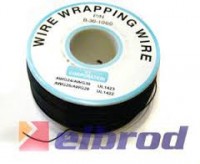mateusz2015_5102 wrote: I mean the kynar as in the picture.
Which one is original and which is a fake?
This photo, commonly known as kynar, is externally very similar to it but differs from the original kynar in terms of insulation material.
The kynar cable (actually the name kynar is the name of the material, not the cable) is much more resistant to temperature (Tefzel is even better) and mechanical exposure.
The downside is the difficulty of stripping and a good price.
This wire, which you have in the picture (usually called incorrectly kynar), is less resistant mechanically (on sharp edges it can easily break through) and thermally (melts at soldering temperature). Although in a lot of applications it is not bad at all, especially at this price. I also use it, where you don't necessarily need the original kynar or tefzel.
Isolation is removed even with nails. And as careful when soldering and do not heat up much and avoiding stretching at some edges, it is suitable e.g. for mounting on universal boards or for permanent connections inside devices, better than other solutions, e.g. so-called telecommunication wires, etc.



